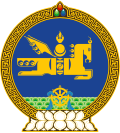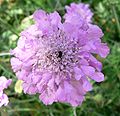Symbols
| Type | Symbol | Image | Notes |
|---|---|---|---|
| Flag | Flag of Mongolia |  | The flag is a vertical triband with a red stripe at each side and a blue stripe in the middle, symbolizing the eternal blue sky, with a yellow Soyombo symbol. |
| Emblem | Emblem of Mongolia |  | The state emblem was adopted in 1992 after the ratification of a new constitution. The emblem features the Wind Horse, the Soyombo symbol, and the Chandmani. |
| National anthem | Mongol Ulsyn töriin duulal ᠮᠣᠩᠭᠣᠯ |  | The national anthem was created and composed in 1950. Its lyrics were changed in 1961, 1991 and in 2006. [1] |
| State seal | State seal of Mongolia |  | The state seal is stamped on important government documents and international agreements. [2] The seal was adopted in 1992 and is held by the President of Mongolia. [3] |
| National symbol | Soyombo symbol ᠰᠣᠶᠤᠮᠪᠤ |  | The Soyombo is a special character in the Soyombo script.created by Mongolian Buddhist spiritual leader Zanabazar in 1686. [4] |
| National currency | Mongolian tögrög |  | The Mongolian tögrög or tugrik was introduced in 1925. [5] |
| National flower | Ber tsetseg |  | The Ber tsetseg was announced the national flora of pride in 2014. [6] |
| National bird | Saker falcon ( Falco cherrug ) |  | The saker falcon was named as the national bird of Mongolia by the Government of Mongolia in 2012. [7] |
| National animal | Takhi |  | The Takhi is the national animal of Mongolia. [8] |
| National pride animal | Mazaalai |  | The Mazaalai was declared as national pride animal by the Government of Mongolia in 2023. [9] |
| National dish | Buuz |  | Buuz is widely considered to be the national dish of Mongolia. [10] |